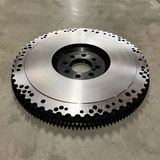Blow off valve: Information and FAQ

Blow off valve intro
Here's how it works: A relief valve (the blow off valve) is connected to the intake manifold / intake system. Inside the valve there is a vacuum chamber containing a spring, membrane and valve. The diaphragm reacts to pressure changes that occur through a vacuum hose that is routed to the intake / plenum and helps keep the valve closed at boost pressure. When the throttle is released and a vacuum is formed in the intake, the diaphragm together with the valve now lifts from its seat and releases the charge pressure.
On some valves, there is an adjustment screw that you can adjust at which pressure the valve should be activated / relieved. If the valve is not adjustable, you instead change the spring to change the pressure at which the valve should be activated.
Blow off valves are often named by diameter. For example, 50mm that is a common size for performance and the aftermarket. Choosing the best valve depends on how much boost pressure you will be running and the physical space available for installation.
Not all older engines are made for an atmospheric blow off valve. They may need a valve that instead circulates the air back into the system, just like an original valve. Both atmospheric and recirculating valves have the same function but the difference is where the excess air goes, out into the atmosphere or back into the engine.
The type of engine control system your car uses determines which valve you should choose. If you have a system measuring air mass (the amount of air entering the intake system), a recirculating valve should be used. If an atmospheric blow off valve is used and air is released into the atmosphere, the ECU cannot calculate the correct amount of air, resulting in incorrect air fuel mixture (lambda), which in turn means poor idle and engine performance. In these systems, excess pressure must be fed back into the turbo system before the compressor inlet, which is what a recirculating valve does.
A control system (ECU) that measures the MAP value (pressure) does not care about the amount of air and then an atmospheric relief valve can be used with advantage as no extra hoses or pipes need to be routed to lead excess air back into the system.
Frequently asked questions about the blow off valve (BOV)
- What does a BOV do?
- Can a BOV be harmful?
- Do you get more power with a BOV?
- Does there have to be a BOV?
1 ▼
What does a Blow Off Valve do?
A BOV releases the pressure in the system when the throttle is released when, for example, shifting. This is to prevent excess pressure from slowing down the turbo compressor wheel.
2 ▼
Can a Blow Off Valve be harmful?
A BOV is not harmful to the engine if it is installed correctly. If, however, it is incorrectly installed, the following can happen.
- It is constantly open and the control system (ECU) tries to compensate with charge pressure and overrevves the turbo unit.
- It is open at idle and dirt enters the system.
- It is too tight and does not release excess air on trottle release which will cause the turbo to slow down. (same as without a BOV)
3 ▼
Do you get more power with a Blow Off Valve?
You don't get more power by just changing the blow off valve. If, on the other hand, you have an original valve that leaks, you can change to a new valve that withstand the pressure and thereby fix a fault. Also, if you have a tuned engine with high airflows, a larger diameter valve may need to be used to be able to evacuate pressure quickly enough, also to not slow down the turbo compressor.
4 ▼
Does there have to be a Blow Off Valve?
Answer yes!
The only job a BOV has is to "evacuate" / get rid of turbo pressure quickly at boost. If this does not happen, the turbo compressor will be slowed down, causing a loss of power through the register.
▼
▼
-
Engine and tuning
- Crankcase ventilation Information
- Engine block: Parts and how they fit together
- Engine deck clearance
- Head gasket - Information
- Engine bearing installation
- Engine bearing Information
- Blow off valve: Information and assembly
- Electronic Throttle Housing - DBW Information
- Noise from engine - Troubleshooting
- ARP bolts: Material and specifications
- Assembly of connecting rods
- Automotive cooling system problem
- Engine cooling system [How does it work?]
- Engine Oil system
- Engine water pump
- Exhaust pipe: Which material should you choose? [+extra information]
- Exhaust system: Parts and assembly
- Exhaust values - Information
- Exhaust wrap
- Intercooler guide
- Oil cooler - Information and FAQ
- Piston ring installation TIPS
- What do notes on Wiseco & JE pistons mean?











































